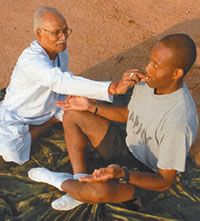Strykers Trade Medical Training
By Sgt. 1st Class Rodney Jackson
E-mail this story | Print this page | Comments (0) | Archive
 Del.icio.us
Del.icio.us
|
Sgt. 1st Class Rodney Jackson
18th Medical Command Public Affairs
CAMP BUNDELA, India - Medical personnel from Headquarters and Headquarters Troop, 2nd Squadron, 14th Cavalry Regiment, “Strykehorse,” 2nd Stryker Brigade Combat Team, 25th Infantry Division, and the Indian Army’s 31 Armored Division gathered Oct. 12 to share information on the most recent medical techniques and applications of medical aids at Camp Bundela, India.
The workshop is part of Yudh Abhyas 09, a bilateral exercise involving the Armies of India and the United States.
The workshop covered material equivalent to the U.S. Army’s Tactical Combat Casualty Care, or TC3, and allowed the group to receive insight from subject matter experts and practice applying the newest trauma bandages, chest seals, pelvic slings and traction splints to each other and mannequins.
“TC3 is more advanced than the typical self aid, buddy aid and combat lifesaver course,” said 2nd Lt. Lawrence Williams, medical operations officer assigned to HHT, 2nd Sqdn. 14th Cav. Regt. “It shows how newer medical aids are used.”
There were many different cutting edge technology aids introduced and trained with during the workshop.
“The course introduces newer air way breathing devices and places emphasis on using newer pressure dressing and combat gauze,” said Sgt. Jesus Torres, emergency care sergeant, HHT, 2nd Sqdn. 14th Cav. Regt. “The workshop was a combined training to show each other’s medical skills and gain ideas from each other.”
Sharing different techniques, aids and applications between the two armies proved helpful.
“Each army’s medical aids may be different, but the basic life-saving aids are the same,” said Indian Army Maj. Sonia Prashar, medical officer, 431st Field Hospital, 31st Armored Division. “The fundamentals of life saving are the same. You have to maintain airway control or breathing; splints serve the same purpose and the principals of using the aids, whether it’s newer or not, remain the same.”
One of the training aids was definitely a benefit for the Indian Army participants.
“The opportunity to work with mannequins was very good for our nursing assistants,” said Prashar. “Working with mannequins is rare for our army and mostly done at our training center for all Indian Armed Forces Medical Services at Lukhnow, India.”
Prashar went on to say, “the opportunity for the different armies to interact was good and the enthusiasm of the trainers was great.
“(The trainers’) expertise was very good. That allowed all (of us) to get to know nice things related to trauma. Their enthusiasm to share (their) knowledge with others during train-the-trainer workshops like this makes you eager to spread the training to others.”
E-mail this story | Print this page |
Comments (0) | Archive |  | RSS
| RSS
Most Recent Comment(s):








